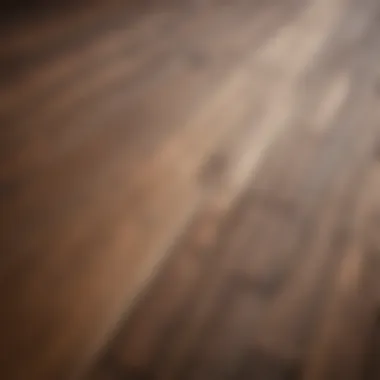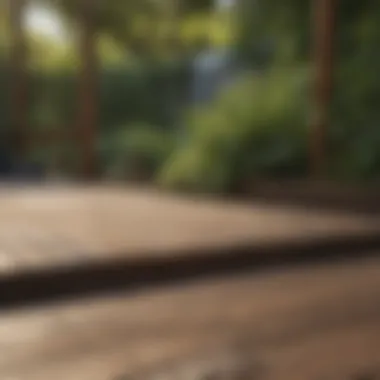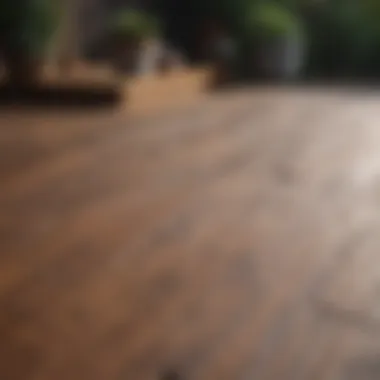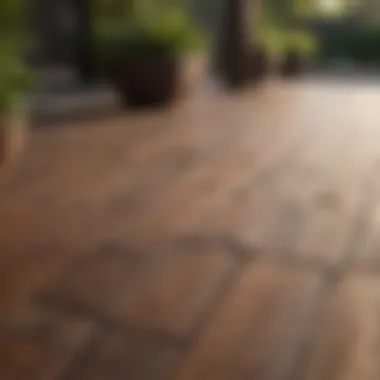Understanding Wood Decking Costs: A Detailed Guide


Intro
In today's market, the allure of wood decking is evident. Homeowners and design enthusiasts alike seek to enhance their outdoor spaces while navigating the complexities of investment. Understanding the price per square foot for wood decking is essential for making informed decisions. This article will unravel various factors influencing costs, from the selection of wood types to installation expenses and market trends.
Design Inspirations
Trending Styles
When considering wood decking, style is critical. Current trends reflect a shift towards sustainability and natural aesthetics. Many homeowners now prefer composite materials or reclaimed wood for their decking projects. These options not only boost visual appeal but also minimize environmental impact. The clean lines of modern design contrast beautifully with the natural grain of thoroughly selected woods such as cedar or redwood.
Color Palettes
Color choices significantly affect the overall ambiance of outdoor spaces. Rich browns and soft beiges can create a warm, welcoming feel. Alternatively, cooler tones, such as gray or white, lend themselves to contemporary settings. Combining different colors can also elevate the visual interest of a deck, encouraging a personalized touch that recognizes the homeowner's unique style.
Maintenance and Upkeep
Seasonal Maintenance Checklist
Proper upkeep is essential to prolong the life of wood decking. A seasonal checklist might include the following:
- Inspect for signs of wear and damage.
- Clean the surface with a gentle detergent and water every spring.
- Apply sealants or stains as necessary to protect the wood every few years.
- Check for loose boards or protruding nails.
Cleaning and Organization Tips
Maintaining a clear and functional space can enhance outdoor enjoyment. Simple cleaning routines can keep the deck presentable. This includes:
- Sweeping debris regularly.
- Storing furniture during harsh weather to prevent wear.
- Using outdoor mats to reduce dirt accumulation.
Remember, regular maintenance assures longevity and beauty of your investment in wood decking.
Ending
Understanding the price of wood decking is multifaceted. With various types of wood available, each carrying its price point, making informed decisions is paramount. This article aims to illuminate key factors influencing costs while inspiring thoughtful choices in style and maintenance. Readers should feel empowered to tackle decking projects with clarity and confidence to create inviting spaces that reflect their personal style.
Prolusion to Wood Decking Pricing
Understanding the pricing of wood decking is vital for homeowners, builders, and design enthusiasts alike. Wood decking is not merely an aesthetic choice; it is a long-term investment in a home’s value and visual appeal. Knowing how much wood decking costs per square foot allows homeowners to budget effectively and avoid unexpected expenses. Furthermore, understanding these prices helps in making informed decisions concerning material quality, design choices, and future maintenance.
In this article, we will explore the various elements affecting wood decking pricing. This exploration includes insights into different types of wood, factors that influence costs, and installation expenses. By providing this information, we aim to clarify the complexities surrounding decking prices, ultimately aiding readers in better financial planning and ensuring satisfaction with their decking projects.
The Importance of Understanding Costs
Understanding wood decking costs plays a significant role in the decision-making process. A clear grasp of pricing helps in setting realistic budgets and timelines. Without this knowledge, one risks overspending or settling for a subpar product due to past miscalculations. Moreover, a comprehensive understanding of various costs associated with wood decking can lead to more sustainable choices, enhancing overall satisfaction.
Being aware of the pricing dynamics enables homeowners to choose options that align with their financial capacity while still achieving desired design outcomes. Hence, it’s not simply about aesthetics or function, but an intricate balance of cost, quality, and durability.
What Influences Pricing?
Several factors contribute to the pricing of wood decking. Here are the main elements:
- Type of Wood: Different woods vary significantly in price. Hardwood, for instance, tends to be more expensive than softwood due to its density and durability.
- Quality of Material: The grade of the wood, as well as any treatments it has undergone, will affect its price. Higher grades of wood will generally cost more.
- Geographic Location: Prices can fluctuate based on regional suppliers and demand. Areas with abundant timber resources may have lower prices compared to locations that require extensive shipping.
- Market Trends: Current trends and economic factors influence overall pricing. Economic fluctuations, supply chain disruptions, and environmental policies can impact availability and cost.
In summary, understanding these influences can aid in making better choices regarding wood decking materials and ultimately lead to successful decking projects.
"A comprehensive view of pricing dynamics empowers consumers and enhances their purchasing decisions."
Grasping these intricacies equips readers to embark on their decking endeavors with confidence and foresight.
Types of Wood Used for Decking
When planning a decking project, selecting the right type of wood is crucial. This choice shapes not only the aesthetic appeal of the space but also the longevity and maintenance needs of the structure. Various wood types come with distinct properties and costs, influencing the overall decking price per square foot. Understanding these options is essential for homeowners and design enthusiasts aiming to make informed financial decisions.
Softwoods vs Hardwoods
The distinction between softwoods and hardwoods is vital when considering wood for decking. Softwoods, such as pine and spruce, tend to be more affordable. However, they might not last as long as hardwoods under harsh weather conditions. Hardwoods, like oak or teak, provide durability and strength. They generally have higher upfront costs but offer extended life and lower maintenance in the long run. Choosing between the two involves balancing budget constraints with desired performance and aesthetic attributes.
Common Species of Decking Wood


Various species of wood are popular choices for decking. Each has its unique features that contribute to overall project considerations.
Pressure-treated lumber
Pressure-treated lumber is a common choice among homeowners due to its affordability and resilience. This type of lumber is chemically treated to resist rot and pest damage. It has a key characteristic of being readily available and cost-effective. Despite its benefits, pressure-treated wood requires regular maintenance, including sealing and staining, to enhance its lifespan and appearance.
Cedar
Cedar is known for its natural resistance to decay and insect damage. It stands out with its pleasant aroma and beautiful grain. Cedar is lightweight yet strong, making it easy to install. Homeowners often opt for cedar for its aesthetic appeal and natural weather resistance. However, it may require more frequent maintenance to sustain its color and charm when exposed to the elements.
Redwood
Redwood offers a unique appeal with rich color variations and appealing grain patterns. Like cedar, it possesses natural resistance to insects and decay. The key characteristic of redwood is its rich red hue, which many find preferable in a backyard setting. However, its higher cost compared to pressure-treated options can be a deterrent for some homeowners. Proper care is necessary to maintain its luster and prevent fading over time.
Composite materials
Composite materials, often made from a mix of wood fibers and plastic, have gained popularity due to their low maintenance demands. They resist fading, scratching, and deterioration. The key feature of composite decking is its long-lasting nature without the need for regular staining or sealing like natural wood. Although initially more expensive, their durability can offset costs in the long run, making them appealing for many homeowners.
Exotic hardwoods
Exotic hardwoods, such as Ipe and Cumaru, are prized for their beauty and durability. They often feature rich colors and dense structures, making them resistant to wear and tear. Their key characteristic is the stunning aesthetics they bring to any project, enhancing the overall value of a property. However, their high cost and sometimes limited availability can be significant downsides. They often need specific care to maintain appearance, but their longer lifespan can justify the investment for some homeowners.
Factors Affecting Wood Decking Prices
Understanding the factors that affect wood decking prices is crucial for any homeowner or enthusiast considering a decking project. Different elements play a significant role in determining the overall cost, including the quality of materials, geographic location, and current market trends. Analyzing these factors will help potential buyers make informed decisions and budget more effectively.
Quality of Material
The quality of the wood used in decking is one of the most significant determinants of price. Higher quality materials tend to cost more due to various reasons. First, superior materials often exhibit greater durability and resistance to environmental stressors such as moisture, insects, and UV exposure. For instance, high-quality hardwoods like mahogany or teak are often more expensive than softwoods like pine due to their dense properties and longevity. Additionally, the method of treatment can also impact pricing. Pressure-treated lumber, which enhances durability, can be more costly than untreated wood. When assessing quality, it's essential to consider not only the wood species but also the supply chain that brings it to market. This can include factors like sustainability practices, regional availability, and conversions needed before installation.
Geographic Location
Geographic location plays a critical role in the overall price of wood decking. Costs can vary widely based on local market conditions and transportation expenses. For example, areas close to lumber mills may benefit from lower prices due to reduced shipping costs. Conversely, regions that rely heavily on imports might see marked-up prices due to longer transportation logistics. Local building codes and climatic conditions can also influence pricing. Areas with stricter regulations may require specific types of materials or treatments, thus affecting the cost for homeowners. Additionally, labor costs vary by location and can significantly influence the final expense of a decking project.
Current Market Trends
Current market trends also heavily influence wood decking prices. Supply and demand dynamics are pivotal; when demand for decking materials surges, prices generally rise. Economic factors such as inflation and availability of raw materials also impact costs. For instance, the COVID-19 pandemic has caused significant interruptions in supply chains, leading to higher lumber prices across the board. Additionally, the trend toward sustainable and eco-friendly materials is growing, which can affect pricing as consumers may be willing to pay a premium for responsibly sourced options. Keeping an eye on these trends can help buyers make timely decisions.
"Investing in a quality deck today can result in savings long term, but careful planning is essential to navigate market fluctuations."
In summary, understanding the factors affecting wood decking prices equips buyers with the knowledge to make informed purchasing decisions. Knowing how material quality, geographic location, and market trends influence costs can provide an edge in budgeting and planning a successful project.
Calculating Wood Decking Costs
Calculating wood decking costs is a fundamental aspect of any decking project. A clear and accurate understanding of costs can help homeowners avoid unexpected expenses. Knowledge of pricing structures allows for better financial planning and project execution. There are specific elements that contribute significantly to the overall cost that must be investigated. Factors like the choice of material, size of the deck, and installation method all play a crucial role in determining the price.
When you begin to analyze the costs associated with wood decking, clarity is essential. This will help in assessing whether a project is feasible within budgetary constraints. Moreover, understanding wood decking prices assists in making educated decisions about material and design. As budgeting becomes more meticulous, there’s room for creativity and consideration without overspending. The following subsections will break down the elements needed to calculate decking costs effectively.
Price Per Square Foot Breakdown
The price per square foot serves as a primary metric in determining overall decking expenses. This measurement provides a straightforward way to compare different wood types and brands. Generally, prices vary based on several influential factors, including:
- Type of Wood: Softwoods like pressure-treated lumber tend to be less expensive than hardwoods such as teak or mahogany.
- Grade of Material: Higher grades often command a premium price due to better aesthetics and durability.
- Finishes and Treatments: Additional treatments for weather resistance or insect repellent can increase cost.
- Supplier Markup: Local market conditions and supplier policies may influence pricing.
Understanding these aspects can help you evaluate quotes you receive and ensure you are getting fair pricing for your choice of decking material. To calculate the full cost, multiply the price per square foot by the total area of the deck. This calculation presents a foundational step before looking into further expenses such as installation or additional materials.
Estimating Material Needs
Estimating your material needs is vital to accurate budgeting. Not accurately gauging how much wood is required can lead to over- or under-purchasing, both of which are problematic. Here’s how to approach the estimation:
- Measure Your Space: Begin by measuring the length and width of the area where the deck will be installed. This calculation will provide a base area.
- Accounting for Design: Consider any design elements such as steps, railings, or curves that may require extra materials. Complex shapes may require more cuts and hence more wood.
- Choose the Right Width of Planks: Depending on the width of the planks selected, you may need to adjust your quantity. Wider planks will cover more area with fewer pieces, potentially reducing costs.
- Include Waste Factor: It's wise to add around 10% more to account for waste. Cuts and imperfections can lead to unusable pieces, and this buffer helps avoid shortages during installation.
By accurately estimating your material needs, you position yourself for a successful decking project while staying within budget. Providing a detailed list of required materials aids in discussions with suppliers or contractors and can streamline the purchasing process.
Installation Considerations
When planning to install wood decking, one must consider various factors that impact both the initial setup and long-term enjoyment of the space. Installation considerations extend beyond merely attaching planks to a framework; they encompass elements like design, location, and professional versus do-it-yourself options. Proper installation affects the durability and safety of the deck, making this aspect crucial to a successful deck project.


DIY vs Professional Installation
Choosing between a DIY approach and hiring a professional can significantly influence costs and overall project satisfaction. DIY installation may seem appealing due to the potential for savings on labor costs. For handy individuals, it provides an opportunity to personalize the design and have a hands-on experience. However, it does demand a good understanding of construction techniques and potential pitfalls. Mistakes during installation could lead to costly repairs later.
Conversely, hiring a professional installer ensures that the project adheres to building codes and best practices. While this option increases upfront costs, it can save time and reduce anxiety over unforeseen complications. Ultimately, the choice should factor in one's skill level, time available, and budget constraints.
Hidden Costs of Installation
Even when a budget for a decking project is established, hidden costs often emerge, complicating financial planning. These costs may vary depending on location and specific requirements of the project.
Permitting fees
Permitting fees can catch homeowners unawares. Obtaining the required permissions from local authorities means an additional expense that is easily forgotten in the early planning stages. These fees ensure compliance with safety and environmental regulations, marking a key characteristic in the overall process. While sometimes perceived as just another cost, they provide the benefit of ensuring the project meets legal standards, which can prevent future headaches.
The unique feature of permitting fees is their variability; they can differ widely by location and project type. Depending on the complexity, some homeowners may face high costs, whereas others might find it more manageable. Therefore, investigating local requirements ahead of time is advisable.
Accessories and additional materials
There are various accessories and additional materials that often come with decking projects. Items such as fasteners, joist hangers, and railings contribute to overall aesthetics and safety, essential components for a successful installation. This aspect is beneficial for those seeking to elevate their deck’s functionality and appearance, making it a common topic in decking discussions.
Unique features about these accessories include their role in longevity and structural integrity. Choosing high-quality fasteners prevents rusting and failure, leading to a longer lifespan for the deck. While these materials do add extra cost, they may save money in maintenance and repairs later.
Labor costs
Labor costs are another significant hidden expense when installing wood decking. Depending on the complexity and time required for installation, these costs can fluctuate dramatically. While DIY eliminates labor costs, investing in professionals ensures skillful workmanship, a notable benefit.
The unique feature of labor costs lies in their unpredictability. Factors such as the number of workers, time needed for completion, and regional wage differences can vary these expenses. For this reason, obtaining multiple quotes and understanding the scope of work is advisable to gain clarity on potential final costs.
Long-term Cost Considerations
Understanding long-term cost considerations is crucial when investing in wood decking. While many people focus on the initial price per square foot, ongoing expenses can significantly influence the total cost of ownership. Factors such as maintenance and durability play a vital role in this equation. Homeowners must evaluate not just the appearance of their decking but also how its long-term performance aligns with their budget and lifestyle goals.
Maintenance Expenses
Maintaining wood decking involves regular upkeep. This includes cleaning, treating, and possibly recoating the surface to prevent rot and damage. Wood is susceptible to various environmental factors, which can lead to wear over time. Regular maintenance can prolong the life of the deck and keep it looking attractive. Here are some common maintenance costs to consider:
- Cleaning Solutions: Specialized cleaners can range in price but are necessary for removing mold and dirt.
- Sealants and Stains: Depending on the type of wood, treatments may be needed every few years. This expense can fluctuate based on the product and application method.
- Repair Costs: Wood decking may require occasional repairs or replacements for damaged boards.
Homeowners should factor these ongoing expenses into their budgeting process to avoid surprises down the road.
Lifespan of Various Wood Types
When selecting wood decking, the lifespan of different materials is an important consideration. Various wood species offer different durability levels, which directly impacts their long-term value. A more durable wood may cost more upfront but could save money over time due to lower replacement or maintenance costs.
Comparison of durability across species
Some wood species are known for their exceptional durability:
- Ipe: Known for its density, Ipe is resistant to rot and insect damage.
- Cedar: Though less durable than Ipe, it offers a beautiful finish and natural resistance to decay.
- Pressure-treated lumber: Typically performs well, especially when maintained properly.
This comparison shows how choosing the right wood can benefit the owner. Investing in a durable species reduces replacement frequency and often provides a better return on investment.
Impact of climate on longevity
Climate significantly affects the lifespan of wood decking. Factors such as humidity, temperature, and exposure to UV rays can determine how well the wood holds up over time. For instance, areas with high moisture may require more frequent maintenance, while others exposed to harsh sunlight may fade faster.
Different species react differently to these variables:
- Tropical hardwoods: They often perform best in humid climates.
- Softwoods: More affected by extreme weather changes, leading to reduced lifespans.
Choosing a wood type that matches the local climate can enhance longevity and reduce maintenance needs. Thus, it is wise to consider not only the wood's initial cost but also the expenses associated with maintaining and replacing it over its lifetime.
Key Point: Long-term costs of wood decking involve more than just the price per square foot. Ongoing maintenance and the choice of materials based on environmental factors play a significant role in overall expense.
Alternatives to Traditional Wood Decking
In the realm of decking materials, alternatives to traditional wood have gained significant traction. Homeowners and designers are increasingly exploring options beyond solid lumber. The shift is rooted in various considerations, such as durability, maintenance, and cost-effectiveness. Understanding these alternatives can help guide decisions that align with both aesthetics and practicality.


Choosing an alternative can offer similar visual appeal without some drawbacks of wooden decks. For instance, wood can warp, fade, or require frequent treatments, leading to more expenses over time. The materials that serve as substitutes often address these concerns effectively, making them worth considering.
Composite Decking Options
Composite decking is a popular choice among homeowners seeking durability and low maintenance. Made from a blend of wood fibers and plastic, this material mimics the look of wood while providing enhanced resilience. One major benefit is its resistance to rot and insect damage, which plagues traditional wood.
Composite decking is available in a variety of colors and finishes. This range allows homeowners to achieve the desired aesthetic without sacrificing quality. Moreover, the material typically has a longer lifespan compared to natural wood, reducing the need for replacements.
However, it is essential to understand the cost associated with composite materials. While the initial investment may be higher than that of traditional wood, the long-term savings in maintenance and replacement can compensate for this difference over time.
When considering composite options, some well-known brands include Trex, TimberTech, and Azek. Each brand offers distinct products that cater to various needs, ensuring that there is an option suitable for most homeowners.
PVC and Vinyl Alternatives
PVC and vinyl decking materials present another avenue for those looking to move away from traditional wood. These materials are entirely synthetic, making them impervious to moisture, which eliminates worries about rot or decay.
One advantage of PVC and vinyl is their outstanding color retention. Unlike wood, these materials do not fade quickly under sunlight, maintaining their aesthetic appeal for years. Furthermore, they require minimal upkeep, as they usually only need regular cleaning to remove dirt and debris.
It is also worth noting that PVC and vinyl may have a higher upfront cost compared to wood, but their durability often justifies the expense. Over time, the total cost of ownership tends to be lower since they won’t require staining or sealing like traditional wood decks.
For homeowners seeking visuals that closely replicate wood grain, some brands provide designs that closely mimic traditional wood aesthetics while reaping the benefits of modern materials. Popular options in this category include brands like EverNew and SimTek.
Ultimately, the choice of decking material should align with personal preferences, budgets, and long-term goals. Exploring alternatives to traditional wood can reveal materials that not only match your vision but also offer practical benefits that enhance overall value.
Case Studies and Examples
When discussing wood decking pricing, examining real-world examples can provide significant insights. Case studies serve as a practical method to assess how various factors influence cost. They highlight specific projects, offering valuable learning experiences for homeowners and designers. This section aims to uncover these insights, demonstrating how to navigate potential pitfalls and capitalize on best practices.
Comparative Cost Analysis of Popular Decking Choices
In this analysis, several popular decking materials are compared to better understand their cost structures. The goal is to give homeowners a clearer picture regarding the investment required for different types of wood decking.
- Pressure-treated Lumber: Brought to market as the cost-effective solution, pressure-treated lumber often ranges from $2 to $5 per square foot. Its appeal lies in durability and accessibility. However, one must consider long-term maintenance costs that may add up over time.
- Cedar Decking: Cedar presents a more aesthetic choice, priced between $3 to $7 per square foot. While its initial cost is higher, its natural resistance to moisture and insects can decrease long-term expenses. Homeowners often report satisfaction with its maintenance balance.
- Redwood Decking: Similar to cedar, redwood ranges from $6 to $12 per square foot. This wood's rich color and texture make it highly sought after. However, its distinctive features come with the necessity for proper upkeep to maintain its visual appeal.
- Composite Materials: For those considering non-traditional options, composite decking can range from $2 to $8 per square foot but lacks the natural aesthetic. Its lower maintenance needs appeal to many but require a careful analysis of long-term costs.
By understanding these price ranges, potential buyers are better equipped to make informed choices. Each material has its unique advantages and drawbacks that users should weigh according to their specific needs and preferences.
Success Stories in Deck Construction
Success stories in decking projects present practical applications of best practices in design and budget management. Observing how others navigated the challenges of decking can encourage a more effective approach to your own project.
One notable example is a homeowner who renovated a backyard with a cedar deck. The project started with a thorough analysis of costs and materials, ultimately leading to an informed choice that matched both aesthetic desires and budget constraints. With research into costs, they identified how to optimize for material expenses while reserving budget for quality installation.
Another case study features a community park that utilized composite materials for its deck installation. This project illustrates the benefits of choosing lower-maintenance options in high-traffic areas, ultimately leading to reduced long-term costs and increased durability. By choosing appropriate materials, they achieved longevity while maintaining a budget.
These stories emphasize the importance of thorough research and planning. They serve as motivational examples for anyone considering a deck installation, highlighting that practical decisions can lead to both functionality and beauty.
"In every decking project, truly understanding costs can make or break the experience. Case studies illuminate pathways to success, ensuring homeowners make informed and beneficial choices."
The case studies support the idea that each decking project can be tailored. With careful consideration and analysis, achieving desired outcomes within budget constraints is possible. This section brings together practical experience and real-world application, making it an essential element in understanding wood decking pricing.
The End and Final Thoughts
In summation, the exploration of wood decking pricing per square foot offers invaluable insights for homeowners and enthusiasts aiming to embark on a decking project. Understanding the complexities of cost not only shapes the budgeting process but also influences decisions regarding materials, installation, and long-term maintenance. The analysis provided in this article highlights key components that contribute to decking costs, such as the type of wood, market dynamics, and installation factors.
A comprehensive grasp of these elements allows for a more strategic approach to purchasing and installing decking. Homeowners are better equipped to make informed choices by recognizing what drives costs, and they can avoid common pitfalls that may arise throughout the decking project lifecycle.
Importance of Knowledge on Pricing
Knowledge enhances confidence when selecting materials, negotiating installation fees, and planning for ongoing maintenance. This translates into long-term satisfaction as homeowners create accessible outdoor spaces that fit their budgets and lifestyle.
Moreover, acknowledging future trends in wood decking prices, as discussed in the subsequent section, prepares homeowners to adapt to evolving market conditions while making more sustainable choices regarding their outdoor spaces.
Key Takeaways from Pricing Analysis
To aid in summarizing the multifaceted discussion on wood decking prices, consider the following key takeaways:
- Material Selection: The type of wood directly affects pricing, where options like pressure-treated lumber tend to be more economical compared to exotic hardwoods.
- Market Influences: Current trends and geographic location play significant roles in cost variation, necessitating research into local market conditions.
- Installation Choices: Whether opting for professional installation or DIY can dramatically alter the complete costs involved.
- Ongoing Costs: Future maintenance and longevity concerns intersect with initial budgeting, ensuring that the lifespan of chosen materials aligns with homeownership goals.
By embracing these insights, readers can navigate the decking landscape with greater assurance, leading to improved project outcomes.
Future Trends in Wood Decking Pricing
Examining anticipated future trends in wood decking pricing is crucial for homeowners looking to make strategic investments. Several factors will likely shape the landscape:
- Sustainability Movement: As demand for eco-friendly materials grows, prices for sustainably sourced woods may fluctuate. Homeowners may find increased value in materials certified for sustainable forestry practices.
- Technological Innovations: Advancements in production methods of composites may lead to cost efficiencies, ultimately affecting affordability in the decking market.
- Global Supply Chain Fluctuations: Events impacting forestry and wood trade can cause price volatility. Awareness of international developments can help homeowners anticipate changes.
- Consumer Preferences: Trends will shape varieties of wood used, as preferences might shift from traditional woods to more durable or low-maintenance options like composite materials.
By staying informed about these trends, homeowners can better navigate their decisions and adapt to emerging market realities. Thus, the interplay of knowledge and market awareness fosters smarter financial planning for decking projects.







